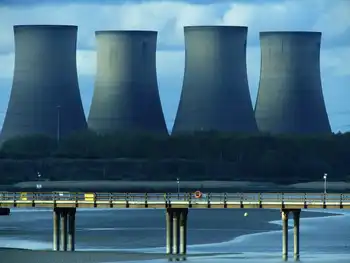Germany - A needed nuclear option for climate change

Arc Flash Training CSA Z462 - Electrical Safety Essentials
Our customized live online or in‑person group training can be delivered to your staff at your location.

- Live Online
- 6 hours Instructor-led
- Group Training Available
Germany Nuclear Debate Amid Energy Crisis highlights nuclear power vs coal and natural gas, renewables and hydropower limits, carbon emissions, energy security, and baseload reliability during Russia-related supply shocks and winter demand.
Key Points
Germany Nuclear Debate Amid Energy Crisis weighs reactor extensions vs coal revival to bolster security, curb emissions.
✅ Coal plants restarted; nuclear shutdown stays on schedule.
✅ Energy security prioritized amid Russian gas supply cuts.
✅ Emissions likely rise despite renewables expansion.
Peel away the politics and the passion, the doomsaying and the denialism, and climate change largely boils down to this: energy. To avoid the chances of catastrophic climate change while ensuring the world can continue to grow — especially for poor people who live in chronically energy-starved areas — we’ll need to produce ever more energy from sources that emit little or no greenhouse gases.
It’s that simple — and, of course, that complicated.
Zero-carbon sources of renewable energy like wind and solar have seen tremendous increases in capacity and equally impressive decreases in price in recent years, while the decades-old technology of hydropower is still what the International Energy Agency calls the “forgotten giant of low-carbon electricity.”
And then there’s nuclear power. Viewed strictly through the lens of climate change, nuclear power can claim to be a green dream, even as Europe is losing nuclear power just when it really needs energy most.
Unlike coal or natural gas, nuclear plants do not produce direct carbon dioxide emissions when they generate electricity, and over the past 50 years they’ve reduced CO2 emissions by nearly 60 gigatonnes. Unlike solar or wind, nuclear plants aren’t intermittent, and they require significantly less land area per megawatt produced. Unlike hydropower — which has reached its natural limits in many developed countries, including the US — nuclear plants don’t require environmentally intensive dams.
As accidents at Chernobyl and Fukushima have shown, when nuclear power goes wrong, it can go really wrong. But newer plant designs reduce the risk of such catastrophes, which themselves tend to garner far more attention than the steady stream of deaths from climate change and air pollution linked to the normal operation of conventional power plants.
So you might imagine that those who see climate change as an unparalleled existential threat would cheer the development of new nuclear plants and support the extension of nuclear power already in service.
In practice, however, that’s often not the case, as recent events in Germany underline.
When is a Green not green?
The Russian war in Ukraine has made a mess of global energy markets, but perhaps no country has proven more vulnerable than Germany, reigniting debate over a possible resurgence of nuclear energy in Germany among policymakers.
At the start of the year, Russian exports supplied more than half of Germany’s natural gas, along with significant portions of its oil and coal imports. Since the war began, Russia has severely curtailed the flow of gas to Germany, putting the country in a state of acute energy crisis, with fears growing as next winter looms.
With little natural gas supplies of the country’s own, and its heavily supported renewable sector unable to fully make up the shortfall, German leaders faced a dilemma. To maintain enough gas reserves to get the country through the winter, they could try to put off the closure of Germany’s last three remaining nuclear reactors temporarily, which were scheduled to shutter by the end of 2022 as part of Germany’s post-Fukushima turn against nuclear power, and even restart already closed reactors.
Or they could try to reactivate mothballed coal-fired power plants, and make up some of the electricity deficit with Germany’s still-ample coal reserves.
Based on carbon emissions alone, you’d presumably go for the nuclear option. Coal is by far the dirtiest of fossil fuels, responsible for a fifth of all global greenhouse gas emissions — more than any other single source — as well as a soup of conventional air pollutants. Nuclear power produces none of these.
German legislators saw it differently. Last week, the country’s parliament, with the backing of members of the Green Party in the coalition government, passed emergency legislation to reopen coal-powered plants, as well as further measures to boost the production of renewable energy. There would be no effort to restart closed nuclear power plants, or even consider a U-turn on the nuclear phaseout for the last active reactors.
“The gas storage tanks must be full by winter,” Robert Habeck, Germany’s economy minister and a member of the Green Party, said in June, echoing arguments that nuclear would do little to solve the gas issue for the coming winter.
Partially as a result of that prioritization, Germany — which has already seen carbon emissions rise over the past two years, missing its ambitious emissions targets — will emit even more carbon in 2022.
To be fair, restarting closed nuclear power plants is a far more complex undertaking than lighting up old coal plants. Plant operators had only bought enough uranium to make it to the end of 2022, so nuclear fuel supplies are set to run out regardless.
But that’s also the point. Germany, which views itself as a global leader on climate, is grasping at the most carbon-intensive fuel source in part because it made the decision in 2011 to fully turn its back on nuclear for good at the time, enshrining what had been a planned phase-out into law.















